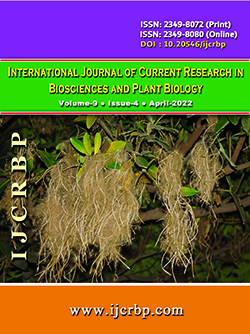 |
Online ISSN : 2349-8080 Issues : 12 per year Publisher : Excellent Publishers Email : editorinchiefijcrbp@gmail.com |
Enset [Ensete ventricosum (Welw) Cheesman] is an economically, nutritionally, and industrially important root crop in Ethiopia. Ethiopia is believed to be the center of origin and diversity of the cultivated enset crop. The crop has been cultivated in the country since time immemorial. The midlands and highlands of Ethiopia are suitable for enset cultivation, particularly southern and southwestern Ethiopia. However, many biotic and abiotic factors are negatively affecting and reducing the production and productivity of the crop in Ethiopia and elsewhere. Of the various bacterial plant diseases limiting enset productivity, bacterial wilt caused by Xanthomonas campestris pv. musacearum (Xcm) is one of the major cosmopolitan and destructive pathogens in all enset- and banana-growing areas. Characteristics or distinguishing symptoms of the disease are yellowing and chlorosis of leaves, wilting, and yellowish secretion of bacterial ooze or exudate from the plant tissue, and dried and dead leftovers of enset plants. This piece of work was undertaken to: 1) review the economic importance and ecological requirements of enset and the extent of total yield loss due to Xcm; 2) review the biology and ecological requirements of the pathogen leading to epidemics; and 3) compile the management options for sustainable enset production and productivity. This review highlights various studies on the importance of the disease and the efforts employed so far in the management of this highly destructive disease to enset production. To achieve these objectives, data and information were gleaned from scientific journal publications, PhD dissertations, Master’s thesis, research reports, books and book chapters, proceedings and symposium papers, relevant compendia, internet resources, personal communications, and similar other resources. From the review insight, it is confirmed that there is no single best enset wilt management option available that farmers rely on and there is a lack of resistant varieties and absence of any work on crop gene improvement so far. Cultural and sanitary measures are the only methods most frequently used across the enset-growing areas and are found to be fruitful in community mobilization to create awareness among the farming community to manage the vascular disease by already known and cheap sanitary measures. Management methods, such as host resistance, botanicals, biological control, and biotechnology approaches also show promising management options against the disease. In conclusion, management of the disease relies on the integration of sanitary and cultural practices along with resistance for sustainable reduction of enset damage due to the disease on farmers’ fields and increased production and productivity of the crop in Ethiopia and elsewhere. In the future, the government has to consider the development of sustainable management strategies as a policy, and awareness creation through mass media and development agents are vital, while regular field monitoring and development of resistant/tolerant varieties are mandatory.
Bacterial vascular wilt,Corm,Disease incidence,Pseudostem,Yield loss
